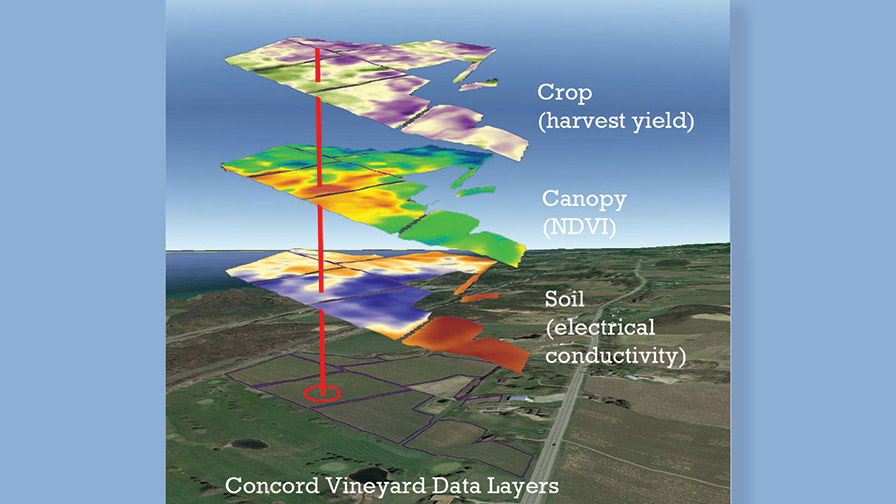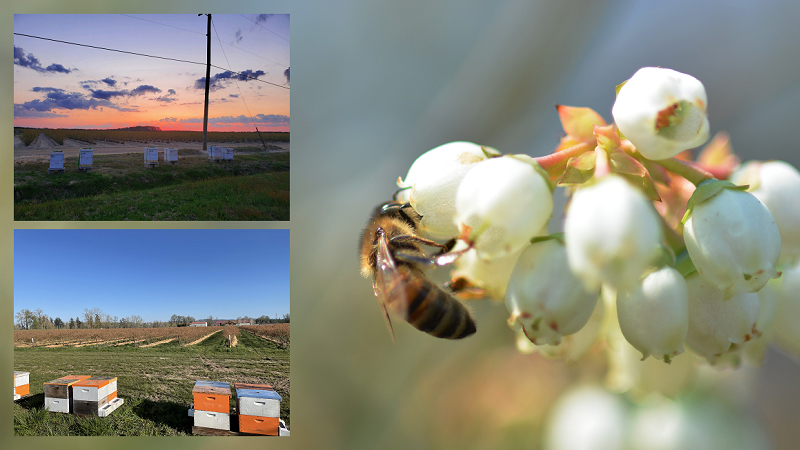Project Helps Grape Growers Use New Technology Effectively in Vineyards

Efficient Vineyard research team seeks to take data collected from different sensors and teach growers how to apply information to better manage variables in the vineyard. (Graphic: Efficient Vineyard Project)
At first glance, a vineyard might seem like a fairly predictable environment. But, think about all the variables in your growing area. Soil types can influence exactly how a canopy can perform, and that can impact yield. It’s not as simple as grapes hanging on a vine. As new technologies are developed to help automate vineyard production, it becomes increasingly important to understand how to use all the data generated.
The biggest challenge to integrating new technology has always been the question of how to use the data that is collected with sensors, drones, and other computer systems. And, this is where the Efficient Vineyard Project comes in.
The project is a national USDA National Institute of Food and Agriculture (NIFA) Specialty Crop Research Initiative funded project. Terry Bates, Senior Research Associate at Cornell University’s School of Integrative Plant Sciences is the project leader. He is joined by leading experts to bring the grape industry into the future, including George Kantor, Senior Systems Scientist at the Robotics Institute at Carnegie Mellon University; James Taylor, Research Scientist at Irstea in France, ) and Integrated Agricultural Production Research Group; Julian Alston, Professor in the Department of Agricultural and Resource Economics of the University of California, Davis; and Tim Weigle, Senior Extension Associate with the New York State Integrated Pest Management Program and Cornell Cooperative Extension.
“This project is based in traditional and sound viticulture concepts: soil health, optimum light interception, appropriate crop load balance,” Bates says. “The goal of this project is to use new and available technology to spatially measure vineyard soil, canopy, and crop characteristics so [growers] can apply their viticulture knowledge appropriately across a vineyard block to achieve their production goals.”
What makes the Efficient Vineyard Project especially interesting is the multi-faceted approach to applying sensors and data in the vineyard. There are individual components of this project that pertain to different grape growers, whether you’re a juice, table, or winegrape grower. The research team is looking at mechanical shoot thinning, mechanical fruit thinning, variable rate lime application, crop estimation, and color development.
“There’s all these little components to this project all the way from sensor development to measuring,” he says. “Making sure the sensor is actually telling us what we want it to, then how it integrates with other data, and then how we put all of that together so it talks to machines.”
Application at Work
At the root of the Efficient Vineyard Project is effectively integrating precision agriculture into the vineyards while increasing efficiencies throughout the vineyard. The scope of this project includes precision vineyard sensing, spatial data, and economics. It is what Bates calls an “integrated look.”
“Managers are out there collecting these piles of pretty pictures on their desk,” he says. “They’re going, ‘What are we supposed to do with this stuff?’ This project gives them an option of ‘What can I actually do with this data.’”
For example, measurements taken with a Normalized Difference Vegetation Index (NDVI) sensor are just an electric signal with viticulture information with it. NDVI readings can help assess the health of crops and plants. But, there’s no viticulture information included with the values collected. The Efficient Vineyard Project validates the readings with how they pertain to the vineyard itself.
“Part of our research is we use the sensors to measure and then we model what the sensors are telling us by going out and taking viticulture measurements against the sensor,” Bates says. “If I get a low NDVI measure, I’ll go measure the canopy and I’ll say ‘OK, I have 30% canopy fill here.’ That means something to a grower. Where if I have an NDVI value of .9, maybe there’s 70% canopy, and that means something to a grower.”
From there, the team can interpret the data and understand what it’ss saying about vine balance, soil quality, or even about the berries themselves. For example, a grower can understand the soil conditions and vine size but also see that the crop load is too high or too low.
“There might be areas where I want to take off 0% crop, or there might be some areas where I want to take off 20%, and there might be some where I want to take off 30%. We build these spatial maps, and we add that map to a field computer that talks to the machine, which controls hydraulics,” he says. “The grower just drives the row, and the machine will speed up or slow down appropriately based on spatial data.”
Next Steps
Essentially, the Efficient Vineyard Project highlights the need for efficient farming with machines, doing the right thing at the right place, and at the right time.
“The problem with a mechanized vineyard is that you’re applying a uniform machine treatment across the whole vineyard in a non-uniform system,” Bates says. “This technology allows them to sit at a desk and say this is how my vineyard differs spatially. I can tell the tractor to do something different in areas A and C, and now I can manage that vineyard mechanically, variably, and keep it healthy and balanced and not have to rely on humans to do it.’”
The 2019 season will be the final year of the Efficient Vineyard Project’s funding. However, the goal is to have all the pieces and parts in place to continue using what the research team has developed.
“My goal is to have all the tools in the toolbox in place so that we can continue doing the research after the project is over,” Bates says. “We’re not doing anything different than what a grower does in his vineyard in a particular area,” he says. “We take the approach of measure, model, manage.”
Growers interested in this project are encouraged to visit EfficientVineyard.com to understand more about the project. The research team also hosts webinars the second Tuesday of every month for growers interested in incorporating the technologies in their own vineyards.










